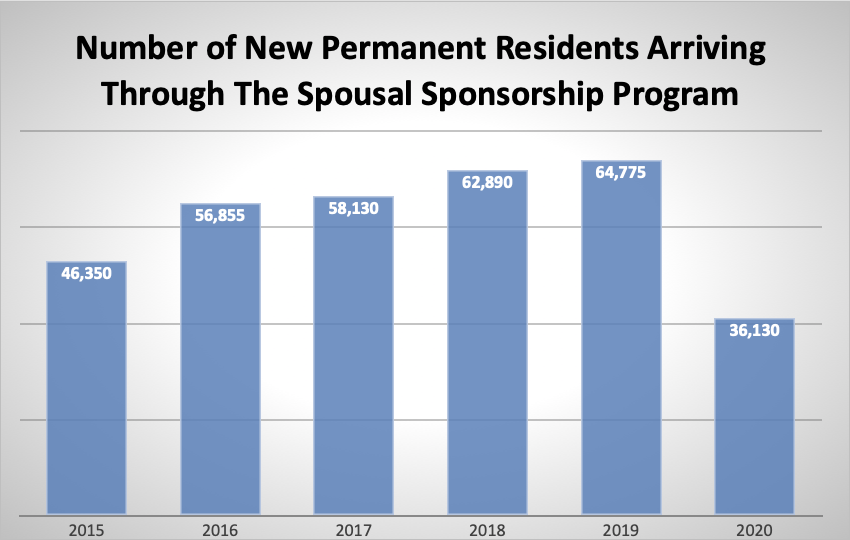
Canada continued to welcome new permanent residents to its provinces and territories under the spousal sponsorship immigration program, even at the height of the COVID-19 pandemic.
In 2020, an impressive 36,130 newcomers became new permanent residents in Canada under these programs – and another 11,675 more arrived in the first quarter of 2021.
Immigration Minister Marco Mendicino has upped the federal government’s capability to process spousal sponsorships to cut down on waiting times. He has also reiterated Ottawa’s commitment to the program which allows immigrants to come to Canada even during times when the border is closed to non-essential travel.
“We understand that the last few months have not been easy for those who are far from their loved ones in these difficult times,” said Mendicino in announcing the measures to speed up processing of spousal sponsorship applications.
“This is why we are accelerating the approval of spousal applications as much as possible,” he said. “Our government will continue to find new ways to keep families together.”
The spousal sponsorship program is a popular way for couples to re-unite in Canada – and that popularity has been on the upswing every year. At least, it was until the pandemic hit.
Read More
- Canada Family Sponsorship Immigration From the Philippines: All You Need To Know
- Canada Family Sponsorship Immigration From India: All You Need To Know
- Family Sponsorship Immigration To Canada: Top 10 Source Countries
- Family Sponsorship An Important Source of New Canada Permanent Residents in 2020
In 2015, 46,350 spouses became new permanent residents of Canada under this program. Five years later, in 2019, that number had grown by more than 39.7 per cent to hit 64,775.
Thousands Become Permanent Residents Through Spousal Sponsorship During COVID-19
COVID-19 slowed down the arrival of spouses under this program last year but not quite as much as it curbed immigration to Canada overall. While the number of new permanent residents to Canada fell by almost 46 per cent in 2020, the number of new permanent residents under the spousal sponsorship program dropped by a slightly lesser amount, 44.2 per cent.
As the third wave of COVID-19 hit Canada hard in the first quarter of this year, the number of new permanent residents under the spousal sponsorship program fell compared to the same three-month period last year – but only by 14.1 per cent.
In order to sponsor a spouse to become permanent resident of Canada, a sponsor needs to be a citizen or an adult permanent resident of Canada capable of supporting him or her financially and ensuring that spouse will not need social assistance from the government.
The fee to sponsor a spouse is $1,050 and the application usually – when Canada is not struggling with a pandemic – takes a year. The person being sponsored may need to provide biometric information.
Under the sponsorship program, the sponsors and their spouses need to sign a sponsorship agreement that explicitly states that the sponsors will provide for the basic needs of the spouses and the spouses will make every effort to support themselves.
Those sponsors who live in Quebec must also meet Quebec’s immigration sponsorship requirements and sign an undertaking with that province.
Sponsors Must Have Financial Means To Support Spouses
Under the spousal sponsorship program in Canada, those who can be sponsored include a spouse, common-law partner, or a conjugal partner.
These are defined as:
- Spouse: a spouse can be someone of either sex and must be legally married to the sponsor and at least 18 years old;
- Common-law partner: this is a person who isn’t legally married to the sponsor, who can be of either sex, and is at least 18 years old and has been living with the sponsor for at least one year in a conjugal relationship;
- Conjugal partner: a person of either sex of at least 18 years of age who isn’t legally married to the sponsor or their common-law husband or wife and has been in a relationship with them for at least one year and lives outside Canada.
Under the spousal sponsorship program, the spouse must also apply for permanent residence and both that application and the sponsorship application must be sent at the same time.
There are four steps to sponsor a spouse.
First, get the application package which includes the:
- document checklist for the sponsor and the spouse;
- forms the sponsor and the spouse need to fill out, and;
- an instruction guide to help fill out the forms correctly.
Processing Times May Be Longer Due To Pandemic
Immigration, Refugees and Citizenship Canada (IRCC) recommends reading the guide carefully before completing the application form. The sponsorship application fee for processing these applications is not refunded.
Once that’s done, it’s important to pay the application fees which include:
- processing fees for the sponsor and the spouse;
- the right of permanent residence fee, and;
- the biometrics fee.
These can be paid online.
Depending on the particular situation, sponsors may need to pay third parties for a medical exam and/or a police certificate.
Mailing instructions are in the application guide but applicants may choose to use a courier service to submit the application to help track it.
Applications can be returned to applicants if they are incomplete or fees are missing.
Any additional information requested by IRCC officials can be sent during the processing of the application. That can include biometric information or updates with any information about a change in circumstances, such as:
- the birth or adoption of children;
- a marriage or divorce or separation, or;
- the death of an applicant or a dependent.
Due to the pandemic, the IRCC has advised applicants that it cannot currently provide accurate processing times because of its limited capacity to process the applications themselves and the greater amount of time needed to send out acknowledgement of receipt (AOR) letters or emails.


